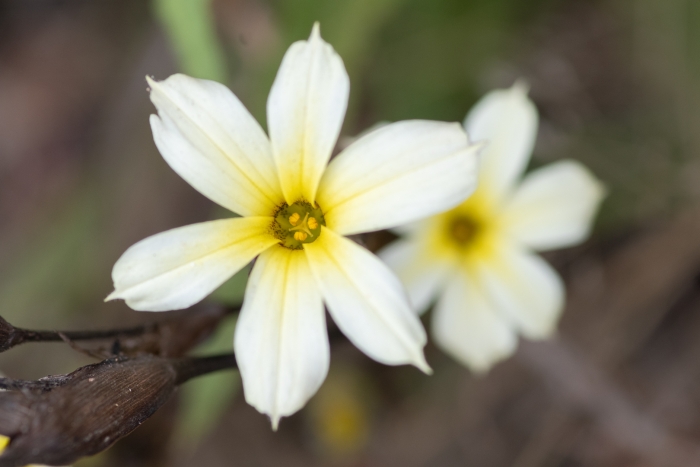Pale Yellow-Eyed Grass
(Sisyrinchium striatum)
Pale Yellow-Eyed Grass (Sisyrinchium striatum)
/
/

Darío De la Fuente
CC BY 4.0
Image By:
Darío De la Fuente
Recorded By:
Copyright:
CC BY 4.0
Copyright Notice:
Photo by: Darío De la Fuente | License Type: CC BY 4.0 | License URL: http://creativecommons.org/licenses/by/4.0/ | Rights Holder: Darío De la Fuente | Publisher: iNaturalist | Date Created: 2021-03-07T14:33:26-08:00 |

















Estimated Native Range
Summary
Sisyrinchium striatum, commonly known as Pale Yellow-Eyed Grass, is an evergreen to semi-deciduous perennial herb native to grasslands and open areas in Argentina and Chile. It typically reaches a height of 70–90 centimeters (28–35 inches). This plant features a clump-forming habit with erect, grey-green, sword-shaped leaves that are arranged alternately on the stem. From late spring to early summer, it produces several clusters of attractive, cup-shaped creamy white flowers with six tepals, each showcasing a striking golden-yellow center that adds to its ornamental value.
Pale Yellow-Eyed Grass is appreciated for its ease of maintenance and the subtle charm of its flowers. It is often used in borders, rock gardens, and as an accent in mixed perennial beds. It thrives in full sun to part shade and requires well-drained soil with moderate moisture. While it is not particularly demanding regarding soil type, it does prefer a loamy or sandy substrate. Gardeners should be aware that in some conditions, Sisyrinchium striatum can self-seed and become somewhat invasive, so monitoring and managing seedlings is advised to prevent unwanted spread.CC BY-SA 4.0
Pale Yellow-Eyed Grass is appreciated for its ease of maintenance and the subtle charm of its flowers. It is often used in borders, rock gardens, and as an accent in mixed perennial beds. It thrives in full sun to part shade and requires well-drained soil with moderate moisture. While it is not particularly demanding regarding soil type, it does prefer a loamy or sandy substrate. Gardeners should be aware that in some conditions, Sisyrinchium striatum can self-seed and become somewhat invasive, so monitoring and managing seedlings is advised to prevent unwanted spread.CC BY-SA 4.0
Plant Description
- Plant Type: Herb
- Height: 1-2 feet
- Width: 1-2 feet
- Growth Rate: Moderate
- Flower Color: Cream, White, Yellow
- Flowering Season: Spring, Summer
- Leaf Retention: Evergreen
Growth Requirements
- Sun: Full Sun
- Water: Medium
- Drainage: Medium
Common Uses
Bee Garden, Bird Garden, Butterfly Garden, Deer Resistant, Drought Tolerant, Groundcover, Rabbit Resistant, Rock Garden, Showy Flowers
Natural Habitat
Native to grasslands and open areas in Argentina and Chile
Other Names
Common Names: Satin Flower
Scientific Names: , Sisyrinchium striatum, Sisyrinchium spicatum, Sisyrinchium libertioides, Sisyrinchium reticulatum, Bermudiana striata, Ferraria ochroleuca, Marica striata, Moraea sertula, Paneguia striata
GBIF Accepted Name: Sisyrinchium striatum Sm.